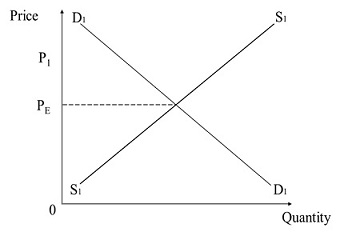Reference no: EM132873985 , Length: word count:3500
MMB725020 Health Economics - Glasgow Caledonian University
Question 1
I. A perfectly competitive market is in equilibrium with price PE, as shown in the diagram below.Describe the impact on this marketif we increase the price to P1from PE? (150 words)

II. Briefly describe the conditions which must be met for a market to be in equilibrium. (300 Words)
III. In a market for health care that does not meet the conditions for market equilibrium it leads to a market for health care insurance. Discuss the concept of adverse selection in health care insurance. (250 Words)
IV. What are the advantages of the Beveridge model of health care? (200 Words)
Question 2
From an economic evaluation of cervical screening strategies the following information on the total cost and total benefits has been found for both the current screening programme and an expanded screening programme.
I. Choose a perspective for this economic evaluation and briefly justify your answer.(150 Words)
|
(1)
|
(2)
|
(3)
|
(4)
|
(5)
|
(6)
|
(7)
|
|
Intervention
|
Total Cost
|
Total Benefit (QALYS)
|
Added cost (£)
|
Added benefit (QALY)
|
Average cost per QALY
|
Incremental Cost per QALY
|
|
Current screening programme (60-69yrs)
|
£75,000,000
|
10,125
|
£75,000,000
|
B
|
C
|
E
|
|
Expanded screening programme (55-74yrs)
|
£115,000,000
|
18,220
|
A
|
8,095
|
D
|
F
|
II. What figures are missing from the table (indicated by A-F) in;
(Please show your calculations)
• Column 4 (box A)
• Column 5 (box B)
• Column 6 (boxes C and D)
• Column 7 (boxes E and F)
III. Explain why decision making should be based on incremental cost per QALY rather than average costs. (150 words)
IV. In economic evaluation, costs and benefits are discounted.What are the reasons for discounting and what are the implications of discounting on funding decisions? (250 words)
Question 3
I. It has been observed that "Quality adjusted life years (QALYs) are the most common way of measuring health benefits in health research". What are the main reasons for this? (200 Words)
II. Why using a generic instrument such as the EQ-5D is useful when compared to condition specific descriptions of health states? (150 Words)
III. What are the strengths and limitations of the standard gamble and time-trade off methods for eliciting utility values of health states? (250 Words)
Question 4
Part 1
I. Why do ‘upstream' public health interventions pose a particular challenge for economic evaluations? (150 words)
II. Different viewpoints might be used for economic evaluation. Explain why the choice of perspective matters for public health interventions? (150 words)
Part 2
I. What are the two ways we can incorporate equity considerations into economic evaluation? (50 words)
II. Briefly describe what is Distributional Cost Effectiveness Analysis (200 words)
Part 3
I. What are the advantages of WTP compared with ‘narrower' approaches to the measurement of health benefits such as QALYs? (250 words)
Question 5
I. Why is priority setting needed in health care? (100 words)
You have been given the following information on two programmes of care, A and B. You have been asked to explain how you would reallocate resources between the two health care programmes to maximise benefits:
|
|
Programme A
|
Programme B
|
|
Marginal cost
|
£250
|
£135
|
|
Marginal benefits (Healthy Years)
|
9
|
7
|
II. How would you reallocate resources between Programme A and B and when would you stop the re-allocation process? (200 Words)
III. Why would you reallocate resources in this way? (150 Words)
IV. State the assumption that lies behind your thinking.(150 Words)
V. Briefly describe the basic premise of both programme budgeting and marginal analysis. (200 Words)